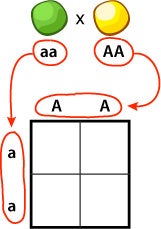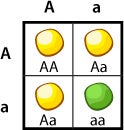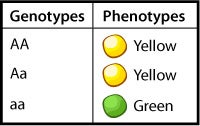Punnett Squares
Punnett squares are a useful tool for predicting what the offspring will look like when mating plants or animals. Reginald Crundall Punnett, a mathematician, came up with these in 1905, long after Mendel's experiments. Let's take a look at how Punnet squares work using the yellow and green peas example from Mendel’s garden experiments.

For every gene, different versions called alleles exist. Alleles control things like pea color or the presence of dimples on your face. Children inherit two alleles for each gene from their parents, one from the mother and one from the father.
The genotype refers to which two alleles an organism has. Sometimes both alleles are the same and sometimes they are different. The phenotype refers to the visible trait that results from the combination of alleles that are present.
Parent Generation
Mendel began his experiments with true breeding strains, meaning plants that have offspring of only one phenotype when mated. In true breeding strains, both alleles are the same for a gene. Since there is only one kind of allele present, mating two plants from the same strain will produce offspring that have the same phenotype and genotype as their parents. Plants or animals with two identical alleles for a gene are said to be homozygous.
First Generation
Mendel first crossed two different true breeding strains together, one that produced yellow peas and one that produced green peas. We’ll use letters to represent alleles. Capital “A” will represent the yellow pea allele and lowercase “a” will represent the green pea allele.
The yellow pea phenotype has a genotype of AA.
The green pea phenotype has a genotype of aa.

When Mendel looked at the results of this mating, he saw that all of the offspring had yellow seeds. How did this happen? If one of the parent plants had green peas, why didn't a single one of the children plants have green peas? We can answer these questions and understand what's happening to the alleles in this crossing with the help of a Punnet Square.
Begin by writing the parents' genotypes along the top and side of the Punnet square.

Next, fill in each cell with two alleles, one from the parent along the top and one from the parent along the side. The letters in the middle show you all possible combinations of alleles that can happen from mating these two genotypes.

In this case, all offspring have the same genotype and phenotype. The order of the letters doesn’t make a difference in the phenotype (aA is the same as Aa) but the capital letter is usually written before the lowercase one. These offspring are said to be heterozygous, meaning that they have two different alleles for pea color.
Despite the fact that both alleles are present in the offspring, the traits did not blend together to result in yellowish-green peas. Instead, only one phenotype was visible and all peas were yellow. Because of this, the yellow pea phenotype is said to be dominant, meaning that it is visible in the heterozygous individual.

Second Generation
For the second generation, Mendel mated the heterozygous offspring from the first generation together.

When Mendel looked at the offspring from this mating, he noticed that 1/4 of the children plants had green seeds. Why did this happen? How was it possible for some of the offspring to have green seeds when both of the parent plants had yellow seeds? Let's once again use a Punnet square to answer these questions and understand what's happening to the alleles in this crossing.

By looking at the Punnett square, we see that there are three possible genotypes that could result from this crossing: AA, Aa, aa. The genotypes AA and Aa will result in the yellow pea phenotype because A is dominant. Only aa will produce the green pea phenotype.

Now we see how it was possible for the green pea phenotype to skip a generation. The green pea allele was present in the F1 generation, but the phenotype was hidden by the yellow pea allele. The green pea phenotype is said to be recessive, meaning that it is only visible in the homozygous individual when the yellow allele is not present.
Probability
In the F2 generation, only 1 of the 4 boxes produced green peas. In other words, 25% of the offspring had green peas. This number tells you the probability, or likelihood, that an offspring will produce green or yellow peas.
We can use the probability to predict how many offspring are likely to have certain phenotype when mating plants or animals with different traits. Just take the probability of a phenotype and multiply it by the total number of offspring. Let's imagine there were 160 total offspring in Mendel's F2 generation. How many peas are likely to be green?
25% green peas x 160 total offspring = 40 green pea offspring
(Don't forget that 25% = 0.25)
Try It Yourself!
To learn more about Mendelian Genetics and the different ways that genes determine phenotype, play our Garden Gene Genius game. It is a fun way to learn about genetics and is a great way to learn how to solve Punnett Squares.
Additional images from Wikimedia. Pea picture by Bill Ebbesen.
Read more about: Solving a Genetic Mystery
Bibliographic details:
- Article: Punnett Squares
- Author(s): Dr. Biology
- Publisher: Arizona State University School of Life Sciences Ask A Biologist
- Site name: ASU - Ask A Biologist
- Date published:
- Date accessed:
- Link: https://askabiologist.asu.edu/punnett-squares
APA Style
Dr. Biology. (). Punnett Squares. ASU - Ask A Biologist. Retrieved from https://askabiologist.asu.edu/punnett-squares
Chicago Manual of Style
Dr. Biology. "Punnett Squares". ASU - Ask A Biologist. . https://askabiologist.asu.edu/punnett-squares
Dr. Biology. "Punnett Squares". ASU - Ask A Biologist. . ASU - Ask A Biologist, Web. https://askabiologist.asu.edu/punnett-squares
MLA 2017 Style

Be Part of
Ask A Biologist
By volunteering, or simply sending us feedback on the site. Scientists, teachers, writers, illustrators, and translators are all important to the program. If you are interested in helping with the website we have a Volunteers page to get the process started.

